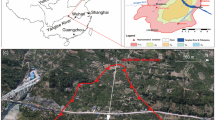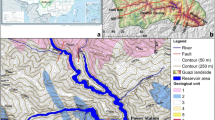Abstract
More than 5000 landslides or potential landslides have been induced in the Three Gorges Reservoir (TGR) region since the impoundment in 2003, which have caused great damage and remain a huge threat to the dam and people living in the reservoir area. Understanding the deformation characteristics and failure mechanism of the landslides can be helpful in stability evaluation and landslide prediction. The primary aim of this study is to research the characteristics of the landslide motion and its relationships with environmental triggers, taking the Quchi landslide, a large, slow-moving, reactivated landslide in the TGR region, as an example. The instability clearly showed visible signs of movements since 2002, and after that, the slope has been experiencing persistent deformation. By combining 4 years of meteorological, hydrological data with displacement measurements from open fractures, deep boreholes, and surface points, as well as in situ observations, this paper reports the geological and geotechnical investigations performed to define the movement. The deformation is believed to be governed by reservoir water levels, while the precipitation has a minor effect. Seasonally, the slope movement has a very distinctive pattern with large deformation starting abruptly right after reservoir drawdown in June and lasting into late summer (September). Then there is a rapid transition to constant deformation (almost no displacement) as the reservoir level rises. The slope displacements appear to gradually increase every year, which suggests very high possibility of the large and overall failure of the slide. Both monitoring results and geomorphological observations have highlighted that the two active slide masses Q1 and Q2 would probably collapse in different kinematic evolution modes, i.e., the multistage failure and whole sliding motion.
















Similar content being viewed by others
References
Boon C, Houlsby G, Utili S (2014) New insights into the 1963 Vajont slide using 2D and 3D distinct-element method analyses. Geotechnique 64(10):800–816
Cloutier C, Locat J, Charbonneau F, Couture R (2015) Understanding the kinematic behavior of the active Gascons rockslide from in-situ and satellite monitoring data. Eng Geol 195:1–15
Crosta GB, Prisco CD, Frattini P, Frigerio G, Castellanza R (2013) Chasing a complete understanding of the triggering mechanisms of a large rapidly evolving rockslide. Landslides 11(5):1–18
Crosta GB, Imposimato S, Roddeman D (2015) Landslide spreading, impulse water waves and modelling of the Vajont rockslide. Rock Mech Rock Eng:1–24
Fourniadis IG, Liu JG, Mason PJ (2007) Landslide hazard assessment in the Three Gorges area, China, using aster imagery: Wushan–Badong. Geomorphology 84(1):126–144
Gu D, Huang D (2016) A complex rock topple-rock slide failure of an anaclinal rock slope in the Wu Gorge, Yangtze River, China. Eng Geol 208:165–180
Gutiérrez F, Linares R, Roqué C, Zarrocab M, Carbonela D, Roselld J, Gutiérreza M (2015) Large landslides associated with a diapiric fold in Canelles Reservoir (Spanish Pyrenees): detailed geological–geomorphological mapping, trenching and electrical resistivity imaging. Geomorphology 241(1):224–242
Huang QX, Wang JL, Xue X (2015) Interpreting the influence of rainfall and reservoir infilling on a landslide. Landslides:1–11
Iadanza C, Trigila A, Napolitano F (2016) Identification and characterization of rainfall events responsible for triggering of debris flows and shallow landslides. J Hydrol 541:230–245
Jian W, Wang Z, Yin K (2009) Mechanism of the Anlesi landslide in the Three Gorges Reservoir, China. Eng Geol 108(1):86–95
Jiao YY, Zhang HQ, Tang HM, Zhang XL, Adoko AC, Tian HN (2014) Simulating the process of reservoir-impoundment-induced landslide using the extended DDA method. Eng Geol 182:37–48
Kilburn CRJ, Petley DN (2003) Forecasting giant, catastrophic slope collapse: lessons from Vajont, Northern Italy. Geomorphology 54(1):21–32
Leroueil S, Locat J, Vaunat J, Picarelli L, Faure R (1996) In: Senneset K (ed) Geotechnical characterisation of slope movements. Proceedings of the seventh international symposium on landslides 1. Rotterdam, Trondheim, Norway, Balkema, pp 53–74
Li J, Xie S, Kuang M (2001) Geomorphic evolution of the Yangtze Gorges and the time of their formation. Geomorphology 41(41):125–135
Liu JG, Mason PJ, Clerici N, Chen S, Davis A, Miao F, Liang L (2004) Landslide hazard assessment in the Three Gorges area of the Yangtze River using ASTER imagery: Zigui–Badong. Geomorphology 61(1–2):171–187
Macfarlane DF (2009) Observations and predictions of the behaviour of large, slow-moving landslides in schist, Clyde Dam reservoir, New Zealand. Eng Geol 109(1):5–15
Peruccacci S, Brunetti MT, Luciani S, Vennari C, Guzzetti F (2012) Lithological and seasonal control on rainfall thresholds for the possible initiation of landslides in central Italy. Geomorphology 139–140(4):79–90
Pinyol NM, Alonso EE, Corominas J, Moya J (2012) Canelles landslide: modelling rapid drawdown and fast potential sliding. Landslides 9:33–51
Qi S, Yan F, Wang S, Xu R (2006) Characteristics, mechanism and development tendency of deformation of Maoping landslide after commission of Geheyan reservoir on the Qingjiang River, Hubei Province, China. Eng Geol 86(1):37–51
Schulz WH, Kean JW, Wang G (2009) Landslide movement in Southwest Colorado triggered by atmospheric tides. Nat Geosci 2:863–866
Schuster RL (1979) Reservoir-induced landslides. B Eng Geol Environ 20:8–15
Semenza E, Ghirotti M (2000) History of the 1963 Vaiont slide: the importance of geological factors. B Eng Geol Environ 59(2):87–97
Sun G, Zheng H, Huang Y, Li C (2016) Parameter inversion and deformation mechanism of Sanmendong landslide in the Three Gorges Reservoir region under the combined effect of reservoir water level fluctuation and rainfall. Eng Geol 205:133–145
Vallet A, Charlier JB, Fabbri O, Bertrand C, Carry N, Mudry J (2016) Functioning and precipitation-displacement modelling of rainfall-induced deep-seated landslides subject to creep deformation. Landslides 13(4):1–18
Van Asch WJ, Malet JP, Bogaard TA (2009) The effect of groundwater fluctuations on the velocity pattern of slow-moving landslides. Nat Hazards Earth Syst Sci 9:739–749
Wang F, Li T (2015) Landslide disaster mitigation in Three Gorges Reservoir, China. Mt res dev 30(2):184–185
Wang F, Zhang Y, Huo Z, Peng X, Wang S (2008) Mechanism for the rapid motion of the Qianjiangping landslide during reactivation by the first impoundment of the Three Gorges Dam reservoir, China. Landslides 5(4):379–386
Wu S, Shi L, Wang R, Tan C, Hu D, Mei Y, Xu R (2001) Zonation of the landslide hazards in the forereservoir region of the Three Gorges Project on the Yangtze River. Eng Geol 59(1):51–58
Zangerl C, Eberhardt E, Perzlmaier S (2010) Kinematic behaviour and velocity characteristics of a complex deep-seated crystalline rockslide system in relation to its interaction with a dam reservoir. Eng Geol 112(1–4):53–67
Acknowledgments
This work is supported by the National Natural Science Foundation of China (Nos. 41672300, 41472245, and 41372332), the Fundamental Research Funds for the Central Universities (No. 106112016CDJZR208804), the Scientific Research Foundation of the State Key Lab. of Coal Mine Disaster Dynamics and Control (No. 2011DA105287-MS201502), and the Chongqing Administration of Land, Resources and Housing (No. CQGT-KJ-2014049).
Author information
Authors and Affiliations
Corresponding author
Rights and permissions
About this article
Cite this article
Gu, D.M., Huang, D., Yang, W.D. et al. Understanding the triggering mechanism and possible kinematic evolution of a reactivated landslide in the Three Gorges Reservoir. Landslides 14, 2073–2087 (2017). https://doi.org/10.1007/s10346-017-0845-4
Received:
Accepted:
Published:
Issue Date:
DOI: https://doi.org/10.1007/s10346-017-0845-4




